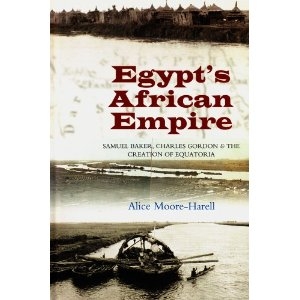|
Reviewed by Wyndham E. Whynot, Ph.D., Associate Professor of History, Livingstone College In the latter part of the nineteenth century, various European powers sought to establish colonies in Africa, setting off the “Scramble for Africa.” While Europeans claimed and colonized most of the continent, Egypt’s own imperialist designs during this same period are often overlooked. Dr. Moore-Harell’s newest book examines Khedive Ismail’s attempts to bring territory in the southern Sudan under Egyptian control, by focusing on expeditions he sponsored that were led by Samuel Baker and Major General Charles Gordon. As the author notes (at the time of publication), Sudan is essentially a culturally-divided country that has and still faces tremendous difficulties that will prove difficult to resolve, meaning that “one must inquire into the circumstances that made Sudan a political entity within its present borders” (p. ix). In doing so, her book focuses on the region known as Equatoria, which in 2011 became part of the nation known as South Sudan. Moore-Harell implies that many of the problems seen within this region have existed over several centuries, and that an understanding of the earlier problems might dictate an appropriate course of action and improve the chances of this new nation’s success. Initially covering the basic geography of the southern Sudan, the Nile River, and other physical challenges faced by individuals traversing the region, she briefly provides an overview of Ismail’s reason for acquiring the region and his decision to select first Baker and then Gordon to lead the separate efforts. The remainder of the text is divided between each individual’s particular mission. Addressing success and failures, Moore-Harell notes that both men faced enormous problems, some self-inflicted and due to their personality characteristics. Baker was essentially a micromanager, while Gordon could be “. . . inconsistent [and] quick tempered. . .” (p. 193). Each mission had multiple objectives: establish Egyptian control over Equatoria, stop the slave trade, gain control over the ivory trade, and (if possible) establish a trade route in Africa’s great lakes region. Demonstrating that neither expedition was completely successful, although Gordon essentially brought the region under Egypt’s control, the author argues at times control only existed when either Gordon, Baker, or their representatives, were present. Both were somewhat successful at reducing the slave trade, yet were unable to completely stop it, and gaining some control over the ivory trade. Unfortunately, certain government officials in Khartoum and within the expedition greatly hindered the expedition, with some actually involved with these enterprises. Additionally, significant logistics, communication, and transportation problems, as well as illness, contributed to the limited success. Similar difficulties, as well as inter-tribal conflicts prevented the development of significant trade routes in the great lakes region. Moore-Harell also discusses Baker’s and Gordon’s shortcomings and the negative impact they had in the region. Gordon believed that Baker’s reliance upon violence against various tribes made it more difficult to establish Egyptian rule. Furthermore, the author indicates that, for the most part, both men generally viewed Egyptians and the tribal peoples as incompetent and (arguably) inferior to Westerners and other “civilized” individuals. She quotes extensively from these men’s letters and papers, showing their attitudes toward Africans in this region. However, both men were well aware that, as Christians operating in areas of Islamic influence, it was important to try to come to terms with the native populations. A welcome addition to the literature of imperialism in Africa, Dr. Moore-Harell’s work is well researched and relies heavily upon primary sources. In addition to the actual papers of the major participants, the author also uses a number of their published autobiographies and biographies about the era and expeditions. Additionally, she utilizes official records from archives in Great Britain, France, Germany, and Egypt to detail various policies regarding trade, especially the slave trade, and the political parties of the time. Her secondary sources represent many of the better-known works on imperialism in Africa, such as Thomas Pakenham’s Scramble for Africa and Adam Hochschild’s King Leopold’s Ghost, among others. Several illustrations of the region and two maps are included in the book. Although well written, this reviewer saw one minor yet jarring error, when the author refers to the American Charles Chaille-Long as being European. Still, this is an excellent book for anyone interested in the eastern African slave trade, Egyptian imperialism in Africa, imperialism in Africa, or the careers of Gordon or Baker. |


 Egypt’s African Empire: Samuel Baker, Charles Gordon & the Creation of Equatoria
Egypt’s African Empire: Samuel Baker, Charles Gordon & the Creation of Equatoria